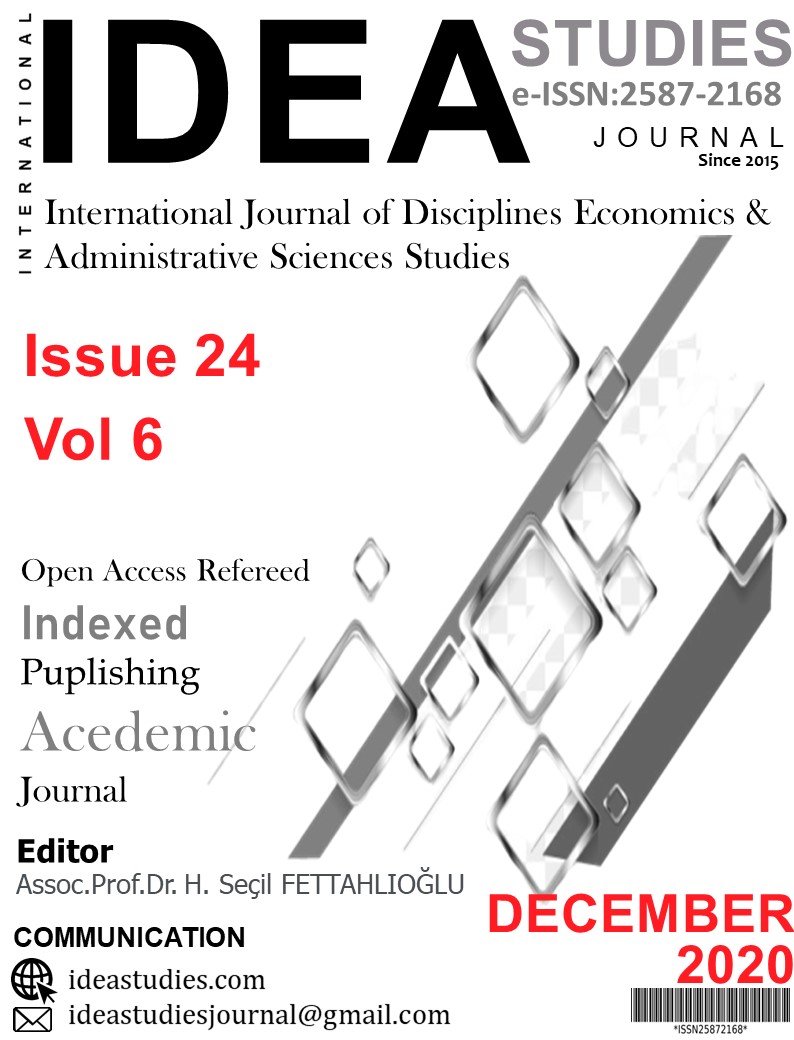ÜRETİCİ FİYAT ENDEKSİ, TÜKETİCİ FİYAT ENDEKSİ, PERAKENDE SATIŞLAR İLE PERAKENDE SEKTÖRÜ GÜVEN ENDEKSİ ARASINDAKİ İLİŞKİLERİN İNCELENMESİ: 2011-2018 YILLARI ARALIĞI
Author :
Abstract
Tüketici Fiyat Endeksi ya da Üretici Fiyat Endeksi enflasyon rakamlarının ölçülmesinde kullanılan iki önemli göstergedir. TÜFE, yıllık enflasyondaki değişimi ölçmek için kullanılan bir endekstir ve bu endekste esas alınan perakende fiyatlarıdır. ÜFE ise üretim aşamasında girdi olarak kullanılan mal ve hizmetin fiyatlarında meydana gelen değişikliği hesaplamak için kullanılan bir endekstir. Ekonomide beklentiler geleceğe dair kuvvetli bir etki oluşturmaktadır. Ortaya çıkan bu etkiyi ölçme ekonomistlerin ilgi alanı haline gelmiştir. Bu etkiyi ölçmek için yapılan ilk şey ise beklentileri hesaplamaktır. Bu nedenle perakende satışlar - perakende güven endeksi ve enflasyon ile ilgili çalışmalar iktisat biliminin önemli konuları arasında yer almaya başlamıştır. Bu çalışmanın amacı, TÜFE, ÜFE, Perakende Satışlar ve Perakende Sektörü Güven Endeksi arasındaki ilişkiyi 2011-2018 dönemi verilerini ele alarak incelemektir. Çalışmada değişkenler arası ilişki Johansen Eş Bütünleşme Analizi Testi ve Granger Nedensellik Analizi çerçevesinde incelenmiştir. Yapılan ampirik araştırmalar incelendiğinde değişkenler arası uzun dönemde bir ilişkinin varlığı elde edilmiştir. Ayrıca Nedensellik Analizi neticesinde ise TÜFE ve ÜFE arasında karşılıklı bir nedensellik ilişkisi elde edilmiştir.
Keywords
Abstract
Consumer Price Index or Producer Price Index are two important indicators used in measuring inflation figures. CPI is an index used to measure the change in annual inflation and is the retail prices that are based on this index. On the other hand, PPI is an index used to calculate the change in the prices of goods and services used as input in the production phase. Expectations in the economy have a strong impact on the future. Measuring this effect has become an area of interest for economists. The first thing to measure this effect is to calculate expectations. For this reason, retail sales - retail confidence index and inflation-related studies have started to be among the important topics of economics. The aim of this study is to examine the relationship between the CPI, PPI, Retail Sales and Retail Sector Confidence Index by considering the data for the 2011-2018 period. In the study, the relationship between variables was examined within the framework of Johansen Cointegration Test and Granger Causality Analysis. When the empirical findings obtained were examined, the existence of a long-term relationship between the variables was obtained. In addition, as a result of causality analysis, a bidirectional causality relationship was found between CPI and PPI.
Keywords
- Abdioğlu, Z., ve Korkmaz, Ö, (2012). Tüketici ve Üretici Fiyat Endeksi Arasında Fiyat
- Abdioğlu, Z., ve Korkmaz, Ö, (2012). Tüketici ve Üretici Fiyat Endeksi Arasında Fiyat Geçişkenliği: Alt Sektörler, Çukurova Üniversitesi İİBF Dergisi, 16(2), ss. 65-81.
- Akçay, S. (2011). The causal relationship between producer price index and consumer price index:Empirical evidence from selected European countries, International Journal of Economics and Finance, 3(6), 227-232.
- Caporale, G. M. , Katsimi, M., ve Pittis, N., (2002). Causality links between Consumer and Producer Prices: Some Empirical Evidence, Southern Economic Journal, 68, ss.703-711.
- Gujarati, N., ve Down, C. P., (2012). Temel Ekonometri, İstanbul, Birinci Basım 899s.
- Granger, J.C.V, (1969). Investigating Causal Relations by Econometric Models and Cross-spectral Methods, 37(3), pp. 424-438.
- Dickey, A. D., ve Fuller, A. W., (1979). Distribution of The Estimators For Autoregressive Time Series With a Unit Root, ‘‘Journal Of American Statistical Associatian’’, 74, 22, ss. 427-431.
- Dickey, A. D., ve Fuller, A. W., (1981). Likelihood Ratio Statistics for Autogressive Time Series with a Unit Root, Economtercia, Vol: 49, No: 4, ss.1057-1072.
- Dorestani, A., ve Arjomand L.H., (2006). An Empirical Study of the Relationship BetweenConsumer and Price Index: A Unit Root Test and Test of Cointegraion, The Coastal Business Journal Spring, Vol:5, No:1 ss. 33-38.
- Johansen, S., (1988). Statistical Analysis Of Cointegration Vectors, Journal Of Economic, Dynamıcs and Control, 12, ss.231-254.
- Johansen, S., ve Jeselius, K., (1990). Maximum Likelihood Estimation and İnference onCointegration With Applications To The Demand For Money, Oxford Bulletion Economıcs And Statistic, 52, ss.169-210.
- MacKinnon ve James. Gordon. (1996). Numerical distribution functions for unit root and cointegration tests, Journal of Applied Econometrics 11(6):601-618.
- Öner, H. (2018). Tüketici ve Üretici Fiyat Endeksi Arasındaki İlişkinin Granger Nedensellik Testi Yoluyla İncelenmesi, Finans Ekonomi ve Sosyal Araştırmalar Dergisi, cilt 3 sayı 1, ss.318-327.
- Özcan, E.S., (2007). Kamu Açık ve Borçlarının Sürdürülebilirliği:1970-2005 Türkiye Örneği”, Dumlupınar Üniversitesi SBE, Doktora Tezi, 227s.
- Saatçioğlu, C. ve Karaca, O., (2017). Türkiye’de Üretici Fiyatları ile Tüketici Fiyatları Arasındaki Nedensellik İlişkisi: 2005-2016, Sakarya İktisat Dergisi, 6(2), ss.1-16.
- Saraç, T.B ve Karagöz, K., (2010). “Türkiye’de Tüketici ve Üretici Fiyatları Arasındaki İlişki: Yapısal Kırılma ve Sınır Testi, Maliye Dergisi, 159, ss.220-232.
- Sidaoui, J., Capistran, C., Chiquiar, D. ve Ramos-Francia, M. (2009). On the predictive content ofthe PPI on CPI inflation: The case of Mexico, Monetary policy and the measurement of inflation:Prices, wages and expectations içinde (249-257.ss.). Bank for International Settlements, BIS Papers, No: 49.
- Tarı, R., (2012). Ekonometri, Umuttepe Yayınları, 8. Baskı, Kocaeli, 518s.
- Tarı, R., Abasız, T. Ve Pehlivanoğlu, F., (2009). “Frekans Alanı Yaklaşımı ile TEFE – TÜFEArasındaki Nedensellik İlişkisi”, 10. Ekonometri ve İstatistiki Sempozyumu, Palandöken, Erzurum.Tiwari, A. K. (2012). An empirical investigation of causality between producers' price andconsumers' price indices in Australia in frequency domain, Economic Model-ling, 29(5), 1571- 1578.
- Tunalı, H. ve Özkan, E., (2016). “Türkiye’de Tüketici Güven Endeksi ve Tüketici Fiyat EndeksiArasındaki İlişkinin Ampirik Analizi,”İktisat Politikaları Araştırmaları Dergisi, cilt 3 sayı 2, ss. 54-TÜİK, (2008). “Türkiye İstatistik Kurumu, Fiyat Endeksleri ve Enflasyon, Sorularla Resmi İstatistikler Dizisi-3”, yayın no:3129, Ankara.
- TÜİK, (2017). Perakende Satış Endeksleri, Haber Bülteni,
- TÜİK, (2014). Yurt içi üretici fiyat endeksi kullanıcıları için bir rehber, Ankara, TÜİK, Basın ve Halkla İlişkiler Müşavirliği.
- Yıldırım, D.Ç. ve Yumuşak, G.İ., (2009). Sağlık Harcamaları ve iktisadi Büyüme İlişkisi ÜzerineEkonometrik İnceleme, The Journal of Knowledge Economy Knowledge Management, Vol: IV, ss. 57-70.
- Zortuk, M., (2008). Türkiye’de Tüketici ve Toptan Eşya Fiyat Endeksi Arasındaki Nedensellik İlişkisi: 1986-2004, Dumlupınar Üniversitesi Sosyal Bilimler Dergisi, 20, ss.181-190





